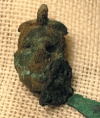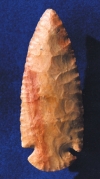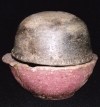|

Click to enlarge |
Geniculate or "L" type bannerstone of gray and
black banded slate. Measures 2 9/16 inches
by 2 inches and is perforated with a typical oval hole. Formerly in the Earl Townsend Jr., collection
tag # 274.
Collection of Bob Yakimicki, Knox, Indiana |

Click to enlarge |
This exceptionally rare wooded Human effigy head (1350 AD to 1450 AD) was carved
from Red Cedar and covered with copper sheeting. Three similar effigies are in the
Gilcrease Museum of Art, Tulsa, Oklahoma.
The effigy measures 1 3/4 inches wide and 2 1/2 inches high. It came
from the Spiro Mound or the Great Mound (renamed the Craig Mound) at
LeFlore County, Oklahoma.
Craig is the largest of the four mounds group measuring 33 feet high
and 112 feet in diameter. This Human Effigy head was purchased by Dr.
C.P. Cherry, Fort Wayne, Indiana
from those who were digging the Great Mound in the 1930's. Later,
Allen Brown, author of "Indian Relics and Their values" 1942 purchased
it from Dr. Cherry. Collection of Bill Kothe, Spencer, Indiana |

Click to enlarge |
Saddleback type Bannerstone (Late Archaic period 3000BC to
500 BC. 3 1/4 inches long, 2 1/4 inches wide, hole 7/16 inches diameter.
Made of light tan polished
limestone. Found winter of 1956/57 at James Bar/Crib mound, Spencer
County, Indiana. Ex. Chalmer Lynch, Clemmons Caldwell collections.
Collection of Richard Burnett, Shelbyville, Kentucky |

Click to enlarge |
This St.Charles/Dovetail is made of Payson chert, a rare material found in
Pike County, Illinois and was formerly in the McNutt collection. Mr. McNutt
is credited with the discovery of this small source of material. Bruce
Filbrandt states he is aware of only two Payson chert dovetails in private
collections.
Collection of David Mosher, Monroe, Wisconsin |

Click to enlarge |
Unusual combination of bowls as they were discovered at the
Greenbrier Bottoms in Arkansas. The top slightly flared rim bowl is
typical grayware with minor punctating surrounding the rim.
The bottom bowl features an extended lip on one side and is painted Old
Town Red on the
exterior of the vessel.
Found by and in the collection of Malcom Ford. |

Click to enlarge |
Type II Adena Expanded Center gorget of blue/gray banded slate. This type has a flattened
contour as opposed to the raised center on Type I. Found in Hardin County, Ohio it was pictured
in Vietzen's, "Ancient Ohioans", later owned by Ron Helman,
John F. Berner and James
Stephan |
|
Copyright © C.S.A.S.I.
|




